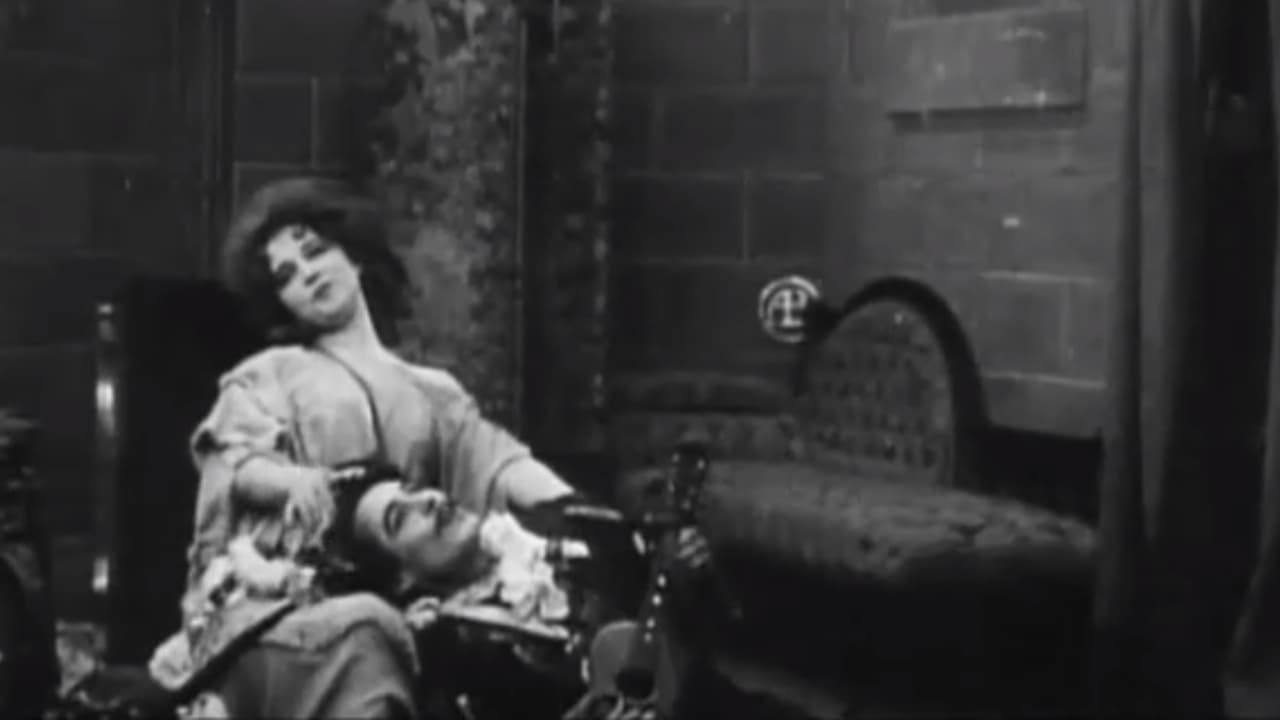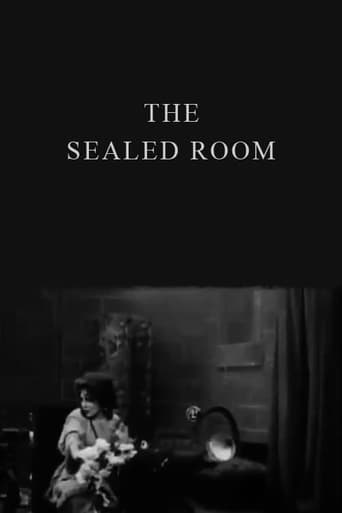


When viewing this short film remember that this is 1909, the infancy of movie making, where they filmed most films in two days with one set camera. The movie making industry is about to boom and by 1915 this film will look ancient compared to the way the movie will be made in just a few years.In this short and simple film, a king sets out to make a private room for him and his queen to have private time from everyone. It was a room that was constructed in the corner of a hall with no windows and only one entrance. But it seems that the queen has eyes for the court minstrel and when the king accidentally finds them in the private room being sweet on each other he sets up on sealing the only entrance to the room.While watching there will be things you have to take for 'film-sake'- like when the wall is being sealed yet the queen and her lover seem not to hear the commotion that is only a few feet away or when they fall to the floor and they go out of sight due to the fix camera shot. These are all part of 1909 regular film making. Watch the film for the historic value and also see the progress movies made in just a few short years. A well preserved film, by D W Griffith, that will not disappoint.
... View MoreI found it interesting that two very famous silent film stars, actress Mary Pickford and director Mack Sennett, had supporting roles in this D. W. Griffith silent film. To add another famous name to the mix, the screenplay was based on an Edgar Allen Poe novel.Yes, this short film looks creaky but it's one year short of being 100 years old, so you can't expect much as far as a big-budget film. It's hard to relate to much at all, actually, because movies were only 10-20 minutes long at that time anyway, and since there was no sound, the actors acted more like mimes.Since "talkies" were still almost two decades away, even the silent actors hadn't quite got their acts down yet. You can see the result: insane overacting and wild, crazy facial expressions - actually laughable at times. But, hey, it was 1909. I find it amazing we still have the opportunity to look at a movie this old, and appreciate the fact it's available.
... View MoreSealed Room, The (1909) *** (out of 4) D.W. Griffith's version of Edgar Allan Poe's 'The Cask of Amontillado' has a King learning that his wife is cheating on him so he seals her and her lover behind a brick wall. This short film manages to have some nice suspense as well as some very good direction from Griffith who gets everything he can out of the story in such a short running time. The ending is wonderfully wicked as well.You've got several options when viewing this title. Image, Kino, Grapevine and a couple public domain companies have released it.
... View MoreAfter not having much luck at selling his screenplays to the new movie industry during the first decade of the 20th Century, in 1908 playwright D.W. Griffith got the job that would make him a legend: he was hired by the Biograph Company as a director of movies. It wasn't really what Griffith had expected when he decided to enter the movie business, but he accepted the job, and in less than a year he became Biograph's most successful director thanks to his original approach to film-making and the wild inventive of his narrative. Many years later, he would direct "The Birth of a Nation" in 1915, the movie that would revolutionize film-making and make him one of cinema's first recognized authors; however, a lot of what would make him a great filmmaker can be found in the many short films he made for Biograph Company in the early years of his career. 1909's "The Sealed Room" is one of those, and also one of the few horror movies of that very first decade of the 20th Century."The Sealed Room" is a story set in the 16th Century in which a Count (Arhtur V. Johnson) has built a windowless room in his castle. It is a small yet nice and very cozy room, as it is meant to be used to enjoy the love and company of his wife, the Countess (Marion Leonard) in a more private way. However, the Count doesn't know that his wife is not exactly faithful, as she is infatuated with the Minstrel (Henry B. Walthall) at Court, with whom she is having an affair. As soon as the Count gets busy with his own business, the Countess calls the Minstrel and both lovers go to enjoy the Count's new room. When the Count returns, he discovers she is missing and begins to suspect, finally discovering the two lovers in his room; but instead of making a scene, he prefers to remain hidden as he decides that there is a better punishment for his unfaithful wife: to seal the windowless room with the couple inside.Written by Griffiths' regular collaborator Frank E. Woods, "The Sealed Room" takes elements from Edgar Allan Poe's "The Cask of Amontillado" and mainly Honoré De Balzac's "La Grande Breteche" to create a haunting Gothic melodrama based on the themes of treachery and sadism. Despite having a runtime of 11 minutes, Woods' screenplay develops the story in a very good way, and plays remarkably well with the horror elements of the story. While a melodrama at heart, Woods focus on the character of the Count and his sadism creates one of the best horror characters of these early era. "The Sealed Room" is definitely a very simple and basic story, but Woods handling of the dark and morbid thematic of its plot makes the story a very entertaining film that was very different than most Griffith's melodramas.In "The Sealed Room", Griffith uses his talents to experiment with tension and suspense in a different way than his usual. While he often played with editing to create thrillers that excited his audience, in this movie his focus was to create desperation and horror, playing with the inherent feeling of claustrophobia that the source stories had. It is interesting how the story starts as another of his melodramas and slowly the pacing becomes faster as the horror themes begin to dominate the plot, culminating in his great use of editing for the final scenes. Not being a movie where camera tricks are essential, what shines the most in "The Sealed Room" is Griffith's talent to direct his actors, as the legendary filmmaker manages to bring the best out of his cast with his usual natural style far removed from the staginess that was the norm in his day.As usual, the cast was comprised of usual collaborators of Griffith, starting with Arthur V. Johnson as the Count. Johnson gives a great performance and truly conveys the character's transition from loving husband to sadistic monster. His performance is not without a touch of overacting, but actually that adds realism to the character's exaggerated personality. As the Countess, Marion Leonard looks very good and is also very effective in her acting, conveying a natural charm that makes hard not to sympathize with her in her treachery. Finally, the legendary Henry B. Walthall appears as the handsome Minstrel, and while far from being one of his best performances, he manages to give a proficient acting that also adds a nice touch of comedy to the film. While not of real importance to the plot, it's nice to see other members of Griffith's stock company in the background, like his wife Linda Arvidson and a young Mary Pickford as nobles at Court.While not exactly a masterpiece, "The Sealed Room" is a notable exercise of editing to create suspense and tension like Griffith used to do in those days. The movie has very good set design and while of a very low budget, Griffith's care for details makes it look very convincing and works perfectly along with his directing style. The change of focus to horror makes it to stand out among other of his films from that era, and Johnson's performance as the sadistic Count makes it worth a watch. While Griffith will always be remembered for his highly influential (and controversial) "The Birth of a Nation", the early short films he made before it really give a good idea of the development of the techniques and the style that would make him a legend. Simple yet elegant, "The Sealed Room" is a fun movie to watch and one of the few horrors of the first decade of the 20th Century. 7/10
... View More